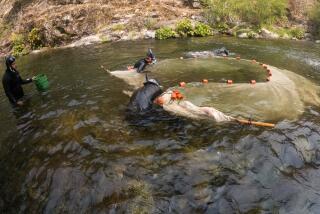This Is a Fish Story That Gives Them a Lift
- Share via
ST. STEPHEN, S.C. — Imagine you’re a hickory shad or a blueback herring swimming through miles of frigid Atlantic water, just trying to answer the call to breed in the lakes of your birth. Suddenly, you’re stopped cold by the 350-foot wide, 80-foot tall St. Stephen’s Dam.
That would be a pretty dismal end, if not for a fish lift, a sort of underwater elevator so fish that live in saltwater and spawn in freshwater can continue their instinctive journey.
More than a million fish of 22 varieties swam through the device during its two-month run a year ago, said Stuart Coale, a state Natural Resources Department biologist. Just as many are expected during this year’s run, which goes through April.
“It’s a pretty neat machine,” Coale said.
Especially for the fish, which without it were doomed to die at the dam’s base while ospreys and cormorants swooped down to grab them.
When the U.S. Army Corps of Engineers planned the hydroelectric dam about 20 years ago, biologists realized the damage it could do to species like the shad, herring and striped bass traveling up Santee River.
Natural Resources biologist Doug Cook said there was no way for fish to reach their natural spawning grounds of lakes Moultrie and Marion.
So a $10 million lift was designed, a complex Lego-like contraption of grates, pulleys, cables and gears. Every March and April since the dam opened in 1985, DNR biologists operate the lift, one of a half-dozen in the country and the only one in the South.
The theory is that fish are attracted by the slacker water in two 300-foot channels by the right shore of the sanctuary pool instead of the churning flow from the dam’s three hydroelectric turbines.
To get the fish to swim into the holding area, biologists trick the fish into swimming against the current by aiming a little stream of water down the right-side channel.
The fish pass through control gates into a 50-foot stretch and wait for the top of the hour, when a biologist pushes the up button.
That sets off a series of actions. The gates close behind the fish and push them into 15-foot by 15-foot water-filled shaft inside the dam. A grate pushes up about 60 feet, stopping at the level of a man-made canal heading to Lake Moultrie.
A final gate is lowered and most of the time, the fish stream out like workers leaving a Wall Street office building at closing time.
“Sometimes in the mornings, we’ll get 10,000 or 15,000 fish on one lift,” Coale said. “That’s a lot of fish.”
That’s also a lot of money for South Carolina’s lucrative fishing industry, which brought in more than $400 million last year, according to Natural Resources estimates.
Ann Contant, a Natural Resources fish technician, said each shad or herring that goes by could wind up as bait at $1 apiece.
“People use herring, they use shad. You know what that is for this state? Money, money,” she said.
Contant has seen sturgeon, a catfish estimated at 100 pounds and numerous other species in her seven years here. She used to be part of a crew counting each fish as it went past an observation window.
Now video cameras catch each fish using the lift. A count will be made this summer.
Steven Nolte, who fishes Lake Moultrie extensively, brought his 11-year-old son, Thomas, to the lift recently, explaining what he called the beauty of man helping nature.
“I’m all for conservation, because I fish a lot, my dad fished and my granddad fished,” Nolte said. “I want to have something left over for my kids.”
More to Read
Sign up for Essential California
The most important California stories and recommendations in your inbox every morning.
You may occasionally receive promotional content from the Los Angeles Times.













